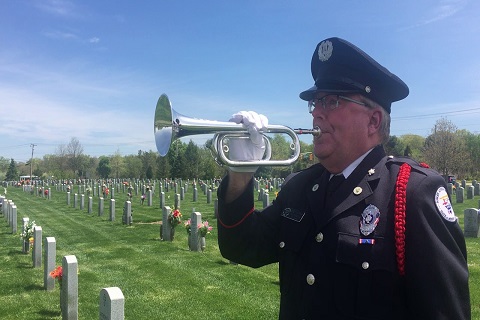George Floyd riots damage just civil rights cause: James S. Robbins
Peaceful protests over George Floyd’s murder have been overshadowed by images of rage-fueled violence and destruction.

to honor police officers killed in-the-line-of-duty each year on May 15.
When it comes to race relations, anyone who thinks rioting is the answer doesn’t grasp the question. Burning, looting and committing mayhem doesn’t bend the moral arc of the universe; it breaks it.
Peaceful protests over George Floyd’s killing have been overshadowed by images of rage-fueled violence and destruction. Resorting to rioting is strange because there is little disagreement that Floyd’s death in custody was senseless and criminal. Few defend the police who were responsible; they were quickly fired, one has been charged with murder, and the Justice Department has opened an investigation into the tragedy. Everyone is on the same side of this issue.
Yet rioting sparked and spread. There is no rational purpose behind people burning buildings, torching cars, breaking windows, spray-painting obscenities and the other actions that have left city blocks looking like war zones. Some say these are expressions of anger and frustration, and maybe so, but they are also unjustified, foolish and counterproductive. While peaceful protesters are trying to create sympathy and build understanding, the rioters have undone that effort with flying bricks and flaming city blocks.
The 1960s civil rights movement drew inspiration from Gandhi’s concept of satyagraha, nonviolent resistance. Martin Luther King Jr. and his followers met the fire hoses and dogs they faced with peaceful marches, prayer, speeches and songs. King’s “I have a dream” speech during the 1963 March on Washington was not immediately followed by nights of terror and vandalism.
The nonviolent approach produced concrete results, in the form of the historic Civil Rights and Voting Rights Acts. But the ideal of peaceful protest was tested by the Watts riots in 1965 and shattered by the “long, hot summer” of 1967. Over 150 riots broke out across the United States, the worst of them in Detroit and Newark. The Kerner Commission report on the violence chalked it up to boiled-over black frustration at a society that denied opportunities to nonwhites. This has been the standard apologia for rioting ever since.
People of all races understand that two wrongs don’t make a right. For example, in 1992 civil unrest erupted in Los Angeles after the acquittal of police officers for beating Rodney King, another case of abuse caught on tape. A 1992 Gallup poll found that 73% of whites and 92% of blacks thought the not guilty verdict was unjustified, yet the same poll found that 79% of whites and 75% of blacks agreed that the rioting was also wrong.
Regardless of why riots happen, they never have a positive outcome. Businesses are destroyed and neighborhoods ruined. Relations with law enforcement worsen; in Baltimore, alleged de-policing after the riots sparked by the death of Freddie Gray in custody in 2015 led to spiraling crime rates. And riots give those who did not want to confront complex issues in the first place a perfect excuse to write it all off to thugs being thugs.
However, it would be a mistake to conclude that what we are seeing is a product of the kind of black despair the Kerner Commission believed caused people to burn down their own neighborhoods in the 1960s. A glance at the livestream videos shows that there are as many if not more white people involved in the turmoil as blacks. Minnesota Gov. Tim Walz suggested that much of the violence has been spawned by opportunistic groups of outside agitators exploiting the tense situation for their radical ends.

In one case caught on video, black community leaders in Minneapolis confronted young white activists, telling them that they would not let them cause “chaos and confusion” in their neighborhoods because “this is not your space. Period.”
Few people in positions of responsibility condone the rioting. Congressman John Lewis of Georgia, who was part of Dr. Martin Luther King’s movement as a young man, urged people to fight again for “equality and justice in a peaceful, orderly, nonviolent fashion,” imploring them to “be constructive, not destructive.” Atlanta Mayor Keisha Lance Bottoms made fiery remarks against the vandals on Friday, saying, “This is not a protest. This is not in the spirit of Martin Luther King Jr. This is chaos.”
On the other hand, there was rapper Cardi B who opined that people had “no choice” other than looting. Odds are that few among her 12 million Twitter followers have any idea who Rep. John Lewis is or why he is a better role model. And as shameful as the looting is, at least it has a purpose, unlike burning down black-owned local businesses in the name of social justice.
The rioters are doing significant harm to their cause. Their actions are completely unjustified. They have no coherent message or stated objective, but only spread misery, fear and anger. Their primary targets, law enforcement and small business owners, are among those most respected groups in American society. Most people don’t want radicals invading their neighborhoods and transforming them into war zones. And a country just emerging from the disruptions of the COVID-19 lockdown will not respond well to their anarchic antics. If the rioters are trying to force people to choose between them and the police, for most people that is an easy choice.
James S. Robbins, a member of USA TODAY’s Board of Contributors and author of “This Time We Win: Revisiting the Tet Offensive,” has taught at the National Defense University and the Marine Corps University and served as a special assistant in the office of the secretary of Defense in the George W. Bush administration. Follow him on Twitter: @James_Robbins


